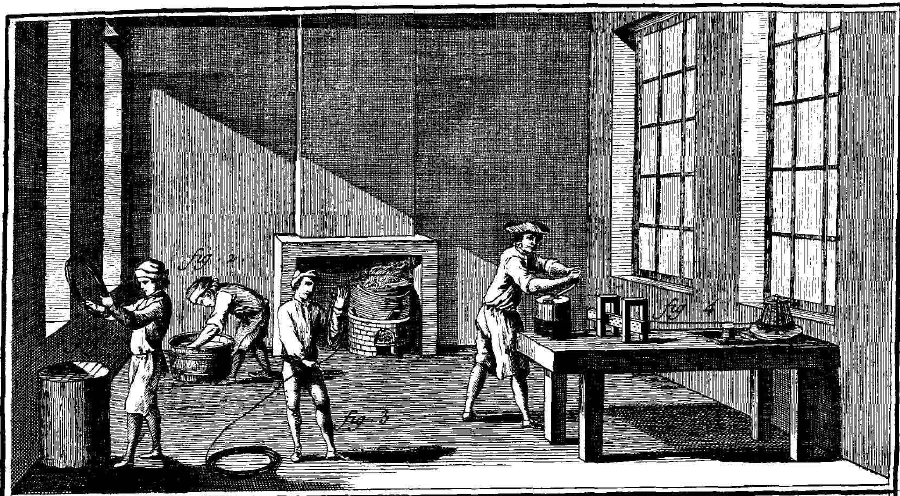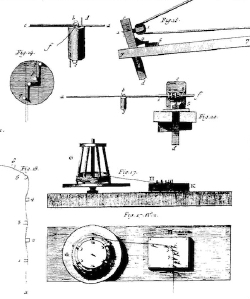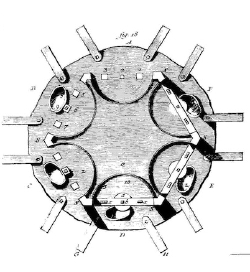Adam Smith and J.B. Say on the Division of Labour
- Collections: The Scotttish Enlightenment
- Collections: The French Enlightenment
- Collections: Economics
The Division of Labour: Adam Smith and the Pin-Maker; J.B. Say and the Playing Card Manufacturer
One of the most famous stories in economics is Adam Smith's story of the pin-maker. It has been repeated endlessly by other economists as it encapsulates quite nicely one of the key insights of economic analysis, namely the benefits of the division of labor. It would have to rank alongside Frédéric Bastiat's story of the broken window in popularity. The purpose of the story is to illustrate how much greater output could be achieved if numerous workers cooperated by taking one small task each in building a complex good like a pin or a nail. Adam Smith developed his ideas about the division of labour in the 1760s and 1770 as he was giving lectures and writing the Wealth of Nations (1776). At the same time Denis Diderot in France was compiling the famous Encyclopédie, ou dictionnaire raisonné des sciences, des arts et des métiers which appeared between 1751 and 1772. The articles in the Encyclopédie were accompanied by beautifully drawn illustrations, such as the ones we include below of a pin factory. Members of both the Scottish and French enlightenments were facsinated by the opportunities offered by technological and economic change in such things as seemingly "very trifling" as the making of a pin.
In the late 1820s the French political economist Jean-Baptiste Say thought he had come up with a better example to illustrate the impact the division of labor was having on productivity. He chose the "perhaps less important" example of the French playing card manufacturing industry which had been a highly regulated industry under the ancien régime but which had been drastiucally deregulated during the revolution (1791), but only to be re-regulated during the Restoration of the monarchy. As a result of the liberalisation in the laws, French entrepreneurs designed and manufactured entirely new types of French playing cards to reflect the ideas of liberty and republicanism as these images from an advertising brochure from 1794, Nouvelles cartes de la République française, show.
A third example comes from the 1837 A Dictionary of Arts, Manufactures, and Mines by Andrew Ure. Of the huge number of industries illustrated in the Dictionary (some 1,600 illustrations of scores of industries) we have selected those which relate to something mentioned in the quotations or to others whose greater productivity and lower costs produced an explosion of industial output in Victorian Britain.
The accompanying essay will have some quotations by Smith, as well as by other political economists such as Turgot, Say, Millar, Marcet, Ricardo, Hodgskin, List, J.S. Mill, Senior, Bastiat, H. Say, and Stewart, ) with appropriate illustrations from the Encyclopédie, Nouvelles cartes, and the Dictionary.
We should also remember some of the famous stories which economists have used in order to make their arguments about free trade and free markets:
- Adam Smith and the Pin Maker (1776)
- Frédéric Bastiat, "The Broken Window" (1850)
- Frédéric Bastiat, "A Petition (From the Manufacturers of Candles)" (1846)
- Leonard Read, "I, Pencil" (1958)
|
|
|
Épinglier (Pin-Maker) I, L'Encyclopédie (1760s) |
|
|
|
Épinglier (Pin-Maker) II, L'Encyclopédie (1760s) |
|
|
|
Épinglier (Pin-Maker) III, L'Encyclopédie (1760s) |
There are four references to "pin-maker" in the writings of Adam Smith between 1763 (when he was giving lectures on jurisprudence at the University of Glasgow) and 1776 when the Wealth of Nations was published. We will list them in chronological order so we can see how his ideas developed over time, before turning to other economists who also used the story of the pin-maker in their own work:
- Adam Smith, Lectures on Jurisprudence (1763, 1766)
- Adam Smith, Wealth of Nations (1776)
- Turgot, Reflections on the Formation and the Distribution of Riches (1770)
- J.B. Say, Treatise on Political Economy (1803)
- John Millar, An Historical View of the English Government (1803)
- Jane Haldimand Marcet, Conversations on Political Economy (1816)
- David Ricardo, Principles of Political Economy and Taxation (1817)
- Thomas Hodgskin, Popular Political Economy (1827)
- J.B. Say, Cours complet d'économie politique pratique (1828)
- Friedrich List, The National System of Political Economy (1841)
- John Stuart Mill, Principles of Political Economy (1848)
- Nassau William Senior, Political Economy (1850)
- Frédéric Bastiat, Economic Harmoneis (1850)
- Horace Say, Dictionnaire de l'économie politique (1852)
- Dugald Stewart, Lectures on Political Economy (1855)
Sources of the illustrations:
- Encyclopédie, ou dictionnaire raisonné des sciences, des arts et des métiers, ed. Diderot and d'Alembert (1751-1772).
- Nouvelles cartes de la République française. Plus de rois de dames de valets; le génie, la liberté, l'égalité les remplacent: la loi seule est au dessus d'eux (Paris: U. Jaume et J.D. Dugourc, 1793-1794). Source : Bibliothèque nationale de France, département Estampes et photographie. Bibliothèque nationale de France. For further information see the illustrated essay at the OLL website.
- A Dictionary of Arts, Manufactures, and Mines: Containing a Clear Exposition of Their Principles and Practice, 2 vols. Edited by Andrew Ure. Illustrated with nearly sixteen hundred engravings on wood. Reprinted from the Fourth English Edition. Corrected and greatly enlarged. (New York: D. Appleton and Company, 1853). Original edition 1835.
Adam Smith, Lectures on Jurisprudence (1763, 1766), and Wealth of Nations (1776)
|
|
|
|
Detail from an illustration in "Épinglier" in the Encyclopédie
|
Detail from an illustration in "Épinglier" in the Encyclopédie
|
Lectures On Jurisprudence, March. 29. 1763
[Smith begins by noting that the division of labour has progressed more in manufacturing than in agriculture. He then takes the "frivolous example" of pin making as a stock case of the greater productivity created by the division of labor in manufacturing such that both higher wages can be paid to the workers and the products created can be sold at a lower price than before.]
The labour of the farmer is intirely seperated from that of the manufacturer. The farmer has his part and the manufacturer his. How many different hands and seperate businesses are there betwixt the grazier who feeds the sheep or the raiser of the flax, and the smoother and presser of the woolen or he who glazes and finishes the linnen. Agriculture however does not admit of this seperation of employment in the same degree as the manufactures of wool or lint or iron work. The same man must often be the plower of the land, sower, harrower, reaper and thresher of the corn (tho here there may be some distinctions). But the difference of the seasons at which these different works are carried on makes it impossible for one to make a livelyhood by any one of these. The thresher, the millar, as they can work equally at all times of the year; the husbandman may also be greatly relieved when the different parts of the work necessary toj provide his instruments are done by other hands, when plow wrights, cart and waggon wrights, smiths who do the iron work of these, are seperated from the others. But still the impracticability of seperating the labour in so great a degree as it is done in the manufactures renders it impossible that the improvements in agriculture should ever keep pace with those in the manufactures. Tho an oppulent state will no doubt far exceed a poorer one both in the culture of the ground and the goodness and cheapness of its manufactures, yet this will not be so remarkable in the produce of the soil as the handycraft trades. Thus the corn of France is generally as good in every respect and as cheap as that of England; but the toys, the buttons, buckes, knives, etc., etc. of the latter far exceed those of the other in neatness, strength of work, and cheapness. When these improvements have been made, each branch of trade will afford enough both to support the oppulence and give considerable profit of the great men, and sufficiently reward the industry of the labourer. Every trade can afford something for those who do not work, and give enough to the industrious. Thus to take the same frivolous example as before, if we should suppose that the pin makers can furnish 1000 pins in the day, that these (including the price of the mettall which is about 20d per pound, out of which many thousand pins may be made) can be sold at the rate of 3 halfpence per 100. The whole thousand will then be worth 15d, of which the artizan can afford 3 to his master and have 12 as the price of his labour, or may give him 200 and retain 800 to himself, for it is the same thing whether we suppose eachl one to have the commodity he works in or the value of his share. If we should again suppose that the pin maker can so contrive it that each man shall make 2000 per diem, and that he sells these at 1d per 100, 20d will be the value of the whole. The master may here have 5 for his share and can afford the artizan 15d. The price of the work will here be less, the publick will be far better supplied, and the artizan will be far better rewarded. The work now costs but very little. The brass wire is about 20d per pound, and after it has been made into pins, of which severall thousands may be made from a pound, it costs no more than 2sh. 6d, so that the price of the work of a lib. of pins is no more than 10d. In this manner the price of labour comes to be dear while at the same time work is cheap, and these two things, which in the eyes of the vulgar appear altogether incompatible, are in this evidently very consistent, as the improvement of arts renders things so much easier done that a great wage can be afforded to the artizan and the goods still be at a low price. That state is opulent where the necessaries and conveniencies of life are easily come at, whatever otherwise be its condition, and nothing else can deserve the name of opulence but this comeattibleness. That is, a state is opulent when by no great pains and a proper application of industry these things may be easily obtaind; and this whether money or other things of that sort abound or not. Industry and well applied labour must always improve the productions, and an opulent state can always afford commodities more reasonably than a poor one.
Source: Adam Smith, Lectures On Jurisprudence, ed. R.. L. Meek, D. D. Raphael and P. G. Stein, vol. V of the Glasgow Edition of the Works and Correspondence of Adam Smith (Indianapolis: Liberty Fund, 1982). Chapter: Tuesday. March. 29. 1763. [Unfortunately we are no longer able to have online the Oxford University Press "Glasgow Edition of the Works of Adam Smith". We have removed any links to these works.]
Lectures On Jurisprudence: March. 30. 1763
[Smith summarizes his argument and then concludes that the money wage is less important than the purchasing power of that wage, which the division of labour increases considerably as his statistics show.]
In yesterdays lecture I shewed you how the division of labour increases the opulence of a nation, which may be justly said to arise from it. If ten men can work in a day 40 times as much as a man by himself, every one does then 4 times what he would by himself; consequently he can afford to sell his good 1/4 part cheaper than formerly; that is, he can exchange the superfluous produce of his labour for a fourth of the former value. In some the encrease is far greater; in the instance already mentiond, a man who should perform all the operations of mining, smelting, forging, splitting, heading, etc. would hardly fournist 24 ten pins in a year, and if his maintenance be valued at 6£, which is very moderate for such an injenious man, he could not sell a pin for less than ten shills. But if by having the wire ready made (as the pin–makers generally have it from Sweden), by which the work has been divided betwixt 5 or 6, the miner, the smelter, etc., and he makes another, if by this means he should be able to makeg 10 pins in a day, he will then in one day do what was formerly a years work, that is, 365 times the former, or to use round numbers 300. If again the pin maker by dividing the work amongst 18 different hands, as it is where well carry'd on, can have work done by the whole, even the slowest which is the forming of the head, to the amount of 2000 pins per man, this is 200 times what was done in the former, and multiplying this into 800,25 the former number, we have 60,000 times as much work done as when it was all done by one man. So that here he can afford his pins for 1/60000 of what he did at first and have as much to himself. And if he should sell them a little dearer, as will be easily allowed, he will have a considerable profit and the work will be cheaper. Thus it is that labour becomes dearer when at the same time work is cheaper; and these two things, which are vulgarily reckond incompatible, are not only altogether compatible but allmost necessarily connected. Labour is not dear or cheap according to the moneyed price payd for it. If 1far or 1d can get a great quantity of the necessarys of life, a farthing or 1d is high wages, that is, if for the moneyd price of his labour he can get a great deal of goods or provisions. A Mogull for 1/2d can get more rice than a man can eat in a day, while the West–Indian labourer can hardly lay by any thing out of 2sh 6d or 3sh per diem, which is his wages. The price of labour is not here so great as in the former case. The opulence of a state depends on the proportion betwixt the moneyd price of labour and that of the commodities to be purchased by it. If it can purchase a great quantity then it is opulent; if a small then it is poor.
Adam Smith, Lectures On Jurisprudence, ed. R.. L. Meek, D. D. Raphael and P. G. Stein, vol. V of the Glasgow Edition of the Works and Correspondence of Adam Smith (Indianapolis: Liberty Fund, 1982). Chapter: | Wednesday. March. 30. 1763.
Lectures On Jurisprudence: 1766
[Smith has a brief summary of his earlier arguments that the division of labour increases output and increses wealth. He states that the benefits of the division of labour cannot be entended to some activities like farming and grazing.]
We shall next shew how this division of labour occasions a multiplication of the product, or, which is the same thing, how opulence arises from it. In order to this let us observe the effect of the division of labour in some manufactures. If all the parts of a pin were made by one man, if the same person dug the ore, melted it, and split the wire, it would take him a whole year to make one pin, and this pin must therefore be sold at the expence of his maintenance for that time, which taking aty a moderate computation would at least be six pounds for a pin. If the labour is so far divided that the wire is ready made, he will not make above 20 per day, which allowing 10 pence for wages makes the pin twopence.11 The pin maker therefore divides the labour among a great number of different persons, | the cutting, pointing, heading, and gilding are all seperate professions. Two or three are employed in making the head, one or two in putting it on, and so on, to the putting them in the paper, being in all eighteen. By this division every one can with great ease make 2000 a day. The same is the case in the linen and woolen manufactures. Some arts, however, there are which will not admit of this division, and therefore they cannot keep pace with other manufactures and arts. Such are farming and grazing. This is entirely owing to the returns of the seasons, by which one man can only be for a short time employed in any one operation. In countries where the season do not make such alterations it is otherwise. In France the corn is better and cheaper than in England. But our toys, which have no dependance on the climate and in which labour can be divided, are far superiour to those of France.
Adam Smith, Lectures On Jurisprudence, ed. R.. L. Meek, D. D. Raphael and P. G. Stein, vol. V of the Glasgow Edition of the Works and Correspondence of Adam Smith (Indianapolis: Liberty Fund, 1982). Chapter: Of Police.
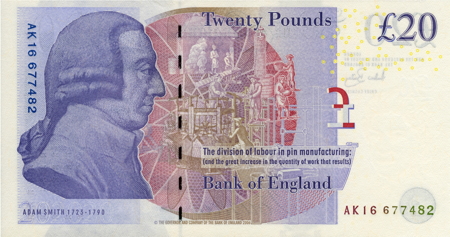 |
|
Adam Smith and Pin Manufacturing on the British 20 Pound Note
|
[This is Smith's most considered expression of the principle which he had worked on for nealry a decade. Again, he dismisses it as a "very trifling manufacture" although he is at pains to show how powerful it is in terms of increasing output. He now tells us that the divisions of the work have now become their own "trades" (or specialities). He also makes the point that the greater output is achieved even without the level of education of the workers being improved.]
To take an example, therefore, from a very trifling manufacture; but one in which the division of labour has been very often taken notice of, the trade of the pin–maker; a workman not educated to this business (which the division of labour has rendered a distinct trade), nor acquainted with the use of the machinery employed in it (to the invention of which the same division of labour has probably given occasion), could scarce, perhaps, with his utmost industry, make one pin in a day, and certainly could not make twenty. But in the way in which this business is now carried on, not only the whole work is a peculiar trade, but it is divided into a number of branches, of which the greater part are likewise peculiar trades. One man draws out the wire, another straights it, a third cuts it, a fourth points it, a fifth grinds it at the top for receiving the head; to make the head requires two or three distinct operations; to put it on, is a peculiar business, to whiten the pins is another; it is even a trade by itself to put them into the paper; and the important business of making a pin is, in this manner, divided into about eighteen distinct operations, which, in some manufactories, are all performed by distinct hands, though in others the same man will sometimes perform two or three of them. I have seen a small manufactory of this kind where ten men only were employed, and where some of them consequently performed two or three distinct operations. But though they were very poor, and therefore but indifferently accommodated with the necessary machinery, they could, when they exerted themselves, make among them about twelve pounds of pins in a day. There are in a pound upwards of four thousand pins of a middling size. Those ten persons, therefore, could make among them upwards of forty–eight thousand pins in a day. Each person, therefore, making a tenth part of forty–eight thousand pins, might be considered as making four thousand eight hundred pins in a day. But if they had all wrought separately and independently, and without any of them having been educated to this peculiar business, they certainly could not each of them have made twenty, perhaps not one pin in a day; that is, certainly, not the two hundred and fortieth, perhaps not the four thousand eight hundredth part of what they are at present capable of performing, in consequence of a proper division and combination of their different operations.
Adam Smith, An Inquiry Into the Nature and Causes of the Wealth of Nations, Vol. I ed. R. H. Campbell and A. S. Skinner, vol. II of the Glasgow Edition of the Works and Correspondence of Adam Smith (Indianapolis: Liberty Fund, 1981). Chapter: [I.i] CHAPTER I: Of the Division of Labour.
Adam Smith, An Inquiry into the Nature and Causes of the Wealth of Nations by Adam Smith, edited with an Introduction, Notes, Marginal Summary and an Enlarged Index by Edwin Cannan (London: Methuen, 1904). Vol. 1. Quotation.
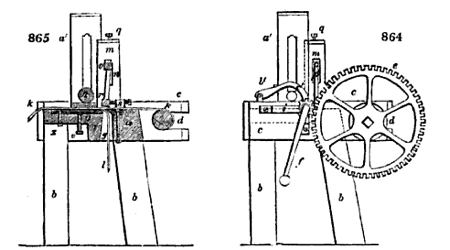 |
|
Illustration from Ure, Dictionary (1854), "Leather Splitting"
|
Turgot, Reflections on the Formation and the Distribution of Riches (1770)
[Turgot does not use the example of the pin maker to make his point about the division of labor. This was made famous with the publication of Smith's Wealth of Nations in 1776. The eample Turgot chooses is that of "the workhouse of a tanner" which supplies leather for the shoe maker. Turgot exphasises less the great output made possible by the division of labour but the accumulation of capital which is necessary before any extended manufacturing process can take place.]
In early times, he that employed labouring people under him, furnished the materials himself, and paid from day to day the salaries of the workmen. It was the cultivator or the owner himself that gave to the spinner the hemp he had gathered, and he maintained her during the time of her working. Thence he passed the yarn to a weaver, to whom he gave every day the salary agreed upon. But those slight daily advances can only take place in the coarsest works. A vast number of arts, and even of those arts indispensable for the use of the most indigent members of society, require that the same materials should pass through many different hands, and undergo, during a considerable space of time, difficult and various operations. I have already mentioned the preparation of leather, of which shoes are made. Whoever has seen the workhouse of a tanner, cannot help feeling the absolute impossibility of one, or even several indigent persons providing themselves with leather, lime, tan, utensils, &c. and causing the requisite buildings to be erected to put the tan house to work, and of their living during a certain space of time, till their leather can be sold. In this art, and many others, must not those that work on it have learned the craft before they presume to touch the materials, lest they should waste them in their first trials? Here then is another absolute necessity of advances. Who shall now collect the materials for the manufactory, the ingredients, the requisite utensils for their preparation? Who is to construct canals, markets, and buildings of every denomination? How shall that multitude of workmen subsist till the time of their leather being sold, and of whom none individually would be able to prepare a single skin; and where the emolument of the sale of a single skin could not afford subsistence to any one of them? Who shall defray the expences for the instruction of the pupils and apprentices? Who shall maintain them until they are sufficiently instructed, guiding them gradually from an easy labour proportionate to their age, to works that demand more vigour and ability? It must then be one of those proprietors of capitals, or moveable accumulated property that must employ them, supplying them with advances in part for the construction and purchase of materials, and partly for the daily salaries of the workmen that are preparing them. It is he that must expect the sale of the leather, which is to return him not only his advances, but also an emolument sufficient to indemnify him for what his money would have procured him, had he turned it to the acquisition of lands, and moreover of the salary due to his troubles and care, to his risque, and even to his skill; for surely, upon equal profits, he would have preferred living without solicitude, on the revenue of land, which he could have purchased with the same capital. In proportion as this capital returns to him by the sale of his works, he employs it in new purchases for supporting his family and maintaining his manufactory; by this continual circulation, he lives on his profits, and lays by in store what he can spare to increase his stock, and to advance his enterprize by augmenting the mass of his capital, in order proportionably to augment his profits.
Source: Anne-Robert-Jacques Turgot, Reflections on the Formation and the Distribution of Riches, trans. William J. Ashley (New York: The Macmillan Co., 1898). Chapter: 67. Different orders of merchants. They all have this in common, that they purchase to sell again; and that their traffic is supported by advances which are to revert with a profit, to be engaged in new enterprizes. </titles/122/36521/937096>.
 |
|
Épinglier (Pin-Maker) III (1760s)
|
J.B. Say, Treatise on Political Economy (1803)
[Say also makes this point about the necesssity of "advances" or saved capital before any extended process of manufacturing can tke place. He also stress the need for investment in "implements and machines" for the pin factory.]
Where concerns of industry are carried on in manufactories, in which one and the same master manufacturer conducts the product through all its stages, he can never establish any great subdivision of the various operations, without great command of capital. For such division requires larger advances of wages, of raw materials, and of tools and implements. Where eighteen workmen manufacture but twenty pins each per day, that is to say, in all 360 pins, weighing scarcely an ounce of metal, the daily advance of an ounce of fresh metal is enough to keep them in regular work. But if, in consequence of division of labour, these same eighteen persons can be brought, as we know they can, to produce 86,400 pins, the daily supply of raw material requisite for their regular employ will be 240 ounces weight of metal; consequently a much more considerable advance will be called for. If we further take into calculation, that there is an interval of probably a month or more, from the purchase of the metal by the manufacturer to the period of his reimbursement by the sale of his pins, we shall find that he must necessarily have at all times on hand, in different stages of progressive manufacture, 30 times 240 ounces of metal; in other words, the portion of his capital vested in raw material alone will amount to the value of 450 lbs. of metal. In addition to which, it must be observed, that the division of labour cannot be effected without the aid of various implements and machines, that form themselves an important item of capital. Thus, in poor countries, we frequently find a product carried through all its stages, from first to last, by one and the same workman, from mere want of the capital requisite for a judicious division of the different operations.
Source: Jean Baptiste Say, A Treatise on Political Economy; or the Production, Distribution, and Consumption of Wealth, ed. Clement C. Biddle, trans. C. R. Prinsep from the 4th ed. of the French, (Philadelphia: Lippincott, Grambo & Co., 1855. 4th-5th ed. ). Chapter: BOOK I, CHAPTER VIII: OF THE ADVANTAGES AND DISADVANTAGES RESULTING FROM DIVISION OF LABOUR, AND OF THE EXTENT TO WHICH IT MAY BE CARRIED. </titles/274/37986/900107>.
[Say then applies the principle of the division of labour to commerce. Just as greater output can be achieved by specialising activity within the factory, so too can different firms within the same industry (here the retail industry) specialise in particular commodities to achieve greater output.]
The same circumstance applies equally to commercial industry. Take the village grocer; the consumption of his groceries is so limited, as to oblige him to be at the same time haberdasher, stationer, innkeeper, and who knows what, perhaps even news-writer and publisher; whereas in large cities, not only grocery at large, but even the sale of a single article of grocery, is a great commercial concern. At Paris, London, and Amsterdam, there are shops, where nothing else is sold but the single article tea, oil or vinegar; and it is natural to suppose that such shops have a much better assortment of the single article, than those dealing in many different commodities at once. Thus, in a rich and populous country, the carrier, the wholesale, the intermediate, and the retail dealer conduct each a separate branch of commercial industry, and conduct it with greater perfection as well as greater economy. Yet they all benefit by this economy; and that they do so, if the explanations already given are not convincing, experience bears irrefragable testimony; for consumers always buy cheapest where commercial industry is the most subdivided. Ceteris paribus, a commodity brought from the same distance is sold cheaper at a large town or fair, than in a village or hamlet.
The limited consumption of hamlets and villages, besides obliging dealers to combine many elsewhere distinct occupations, prevents many articles from finding a regular sale at all seasons. Some are not presented for sale at all, except on market or fair days; on such days the whole week's or perhaps year's consumption is laid in. On all other days, the dealer either travels elsewhere with his wares, or finds some other kind of occupation. In a very rich and very populous district, the consumption is so great, as to make the sale of one article only, quite as much as a trader can manage, though he devote every day in the week to the business. Fairs and markets are expedients of an early stage of national prosperity; the trade by caravans is a still earlier stage of international commerce; but even these expedients are far better than none at all.
Source: Jean Baptiste Say, A Treatise on Political Economy; or the Production, Distribution, and Consumption of Wealth, ed. Clement C. Biddle, trans. C. R. Prinsep from the 4th ed. of the French, (Philadelphia: Lippincott, Grambo & Co., 1855. 4th-5th ed. ). Chapter: BOOK I, CHAPTER VIII: OF THE ADVANTAGES AND DISADVANTAGES RESULTING FROM DIVISION OF LABOUR, AND OF THE EXTENT TO WHICH IT MAY BE CARRIED. </titles/274/37986/900102>.
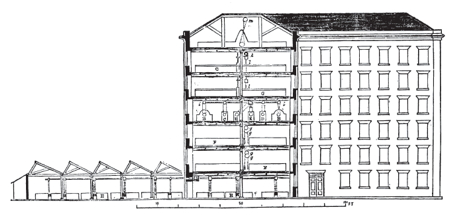 |
|
Illustration from Ure, Dictionary (1854), "Cotton Factory"
|
John Millar, An Historical View of the English Government (1803)
[John Millar makes a similar point as Smith (1766), that the benefits of the division of labour cannot be applied to all industries - again the example of agriculture is given as an industry where this would not work. Millar goes on to stress the greater diversity of talents an agricultural labourer must have compared to a specialised pin maker but the latter has the benefits of town life, such as clothing and book learning, and will thus be more attractive to the young ladies.]
Even in the same country, there is a sensible difference between different professions; and, according as every separate employment gives rise to a greater subdivision of workmen and artificers, it has a greater tendency to withdraw from them the means of intellectual improvement. The business of agriculture, for example, is less capable of a minute subdivision of labour than the greater part of mechanical employments. The same workman has often occasion to plough,<154> to sow, and to reap; to cultivate the ground for different purposes, and to prepare its various productions for the market. He is obliged alternately to handle very opposite tools and instruments; to repair, and even sometimes, to make them for his own use; and always to accommodate the different parts of his labour to the change of the seasons, and to the variations of the weather. He is employed in the management and rearing of cattle, becomes frequently a grazier and a corn-merchant, and is unavoidably initiated in the mysteries of the horse-jockey. What an extent of knowledge, therefore, must he possess! What a diversity of talents must he exercise, in comparison with the mechanic, who employs his whole labour in sharpening the point, or in putting on the head of a pin! How different the education of those two persons! The pin-maker, who commonly lives in a town, will have more of the fashionable improvements of society than the peasant; he will undoubtedly be better dressed; he will, in all probability, have more book-learning, as well as less coarseness in the tone of his voice, and less uncouthness in his appearance and deportment. Should they both be enamoured of the same female, it is natural to suppose, that he would make the better figure in the eyes of his mistress, and that he would be most likely to carry the prize. But in a bargain, he would, assuredly, be no match for his rival. He would be greatly inferior in real intelligence and acuteness; much less qualified to converse with his superiors, to take advantage of their foibles, to give a plausible account of his measures, or to adapt his behaviour to any peculiar and unexpected emergency.
Source: John Millar, An Historical View of the English Government, From the Settlement of the Saxons in Britain to the Revolution in 1688, in four volumes, edited by Mark Salber Philips and Dale R. Smith, introduction by Mark Salber Philips (Indianapolis: Liberty Fund, 2006). Chapter: CHAPTER IV: How far the Advancement of Commerce and Manufactures has contributed to the Extension and Diffusion of Knowledge and Literature. </titles/1886/107989/2268349>.
 |
|
Épinglier (Pin-Maker) II (1760s)
|
Jane Haldimand Marcet, Conversations on Political Economy (1816)
[Marcet popularized Smith's ideas for people who were not well versed in economic theory. She used a constructed conversation between a Smithian economist and someone who was ignorant of the ideas. Here "Mrs. B." talks about how the division of labour allows the acqisition of greater "dexterity" in the worker, the focusing of their attention on one task, and the lack of interruptions in the work, all of which are jsut more efficient ways of worker. But she also argues a new point, namely that by concentrating on one task the woker can begin to think of new ways of doing things and even invent their own machines.]
Mrs. B.
I will now point out to you some examples remarked by Adam Smith in illustration of the benefits derived from the division of labour. That of the pin manufactory I shall give you in his own words...[Mrs. B. then quotes Smith on the pin makers at length.]
Caroline.
These effects of the division of labour are really wonderful!
Mrs. B.
The instance which Adam Smith quotes in proof of the dexterity acquired by men, whose labour is reduced to one simple operation, is also very remarkable. After observing that a man unaccustomed to a blacksmith's forge can with difficulty make three hundred nails in a day, he says that a common blacksmith can forge one thousand; but that he has seen boys who have been brought up to the art of nail-making exclusively, acquire such a degree of dexterity as to complete two thousand three hundred in a day.
Caroline.
The difference is prodigious: but I can conceive it when I observe with what awkwardness a man handles the tools of an art with which he is unacquainted, whilst they are used with ease and dexterity by those who are accustomed to them.
Mrs. B.
Then we must consider that when a man's whole attention and talents are turned to one particular object, there is a much greater probability of his discovering means of improving his workmanship, or facilitating and abridging his labour, than if his mind were engaged in a variety of pursuits. It is most frequently to workmen, that we are indebted for improvements in the process and instruments of labour.
Another advantage derived from the division of labour is the regular and uninterrupted manner in which it enables the work to proceed. A labourer who has many diversified occupations not only loses time in going from one to another, but also in settling himself to his different employments: and, to use a common expression, as soon as his hand is in, he must quit his work to take up another totally different. Thus he must go from his plough to his loom, from his loom to his forge, from his forge to his mill, — but no — there could be neither plough, nor loom, nor forge, nor mill, before a division of labour had taken place; for no man could either find time or acquire skill to construct such machines, unless they could bestow the whole of their labour and attention upon them.
The construction of machines, therefore, we may consider as a refined branch of the division of labour. Their effect in facilitating and abridging labour is almost incredible. How easy, for instance, the operation of grinding corn is rendered by so simple a machine as a wind-mill, or a water-mill! Were this to be done by manual labour, by bruising it between stones, it would be almost an endless task: the hand-mill, which is still in general use in India and many other countries, requires both time and labour; whilst in the wind-mill, or the water-mill, the natural motion of the air, or water, performs nearly the whole of the work.
caroline.But the cotton-mills we have lately seen are a much more wonderful example of the effect of machinery. In these a steam-engine sets all the wheels and spindles in motion, and performs the work of hundreds of people.
Source: Jane Haldimand Marcet, Conversations on Political Economy; in which the elements of that science are familiarly explained, 6th edition revised and enlarged (London: Longman, Rees, Orme, Brown, and Green, 1827). Chapter: CONVERSATION V.: ON THE DIVISION OF LABOUR. </titles/2048/145781/2727167>.
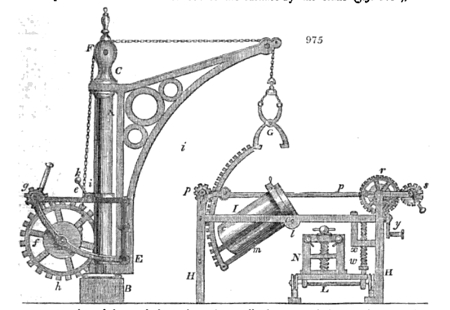 |
|
Illustration from Ure, Dictionary (1854), "Mint"
|
David Ricardo, Principles of Political Economy and Taxation (1817)
[Ricardo is one of the outliers when it comes to the benefits of the division of labout. he argues, based on his view that labour is the determnining factor in value, the introduction of machinery and the division of labour may well increase output but not the total amount of value.]
Value, then, essentially differs from riches, for value depends not on abundance, but on the difficulty or facility of production. The labour of a million of men in manufactures, will always produce the same value, but will not always produce the same riches. By the invention of machinery, by improvements in skill, by a better division of labour, or by the discovery of new markets, where more advantageous exchanges may be made, a million of men may produce double, or treble the amount of riches, of "necessaries, conveniences, and amusements," in one state of society, that they could produce in another, but they will not on that account add any thing to value; for every thing rises or falls in value, in proportion to the facility or difficulty of producing it, or, in other words, in proportion to the quantity of labour employed on its production. Suppose with a given capital, the labour of a certain number of men produced 1000 pair of stockings, and that by inventions in machinery, the same number of men can produce 2000 pair, or that they can continue to produce 1000 pair, and can produce besides 500 hats; then the value of the 2000 pair of stockings, or of the 1000 pair of stockings, and 500 hats, will be neither more nor less than that of the 1000 pair of stockings before the introduction of machinery; for they will be the produce of the same quantity of labour. But the value of the general mass of commodities will nevertheless be diminished; for, although the value of the increased quantity produced, in consequence of the improvement, will be the same exactly as the value would have been of the less quantity that would have been produced, had no improvement taken place, an effect is also produced on the portion of goods still unconsumed, which were manufactured previously to the improvement; the value of those goods will be reduced, inasmuch as they must fall to the level, quantity for quantity, of the goods produced under all the advantages of the improvement: and the society will, notwithstanding the increased quantity of commodities, notwithstanding its augmented riches, and its augmented means of enjoyment, have a less amount of value. By constantly increasing the facility of production, we constantly diminish the value of some of the commodities before produced, though by the same means we not only add to the national riches, but also to the power of future production. Many of the errors in political economy have arisen from errors on this subject, from considering an increase of riches, and an increase of value, as meaning the same thing, and from unfounded notions as to what constituted a standard measure of value.
Source: David Ricardo, The Works and Correspondence of David Ricardo, ed. Piero Sraffa with the Collaboration of M.H. Dobb (Indianapolis: Liberty Fund, 2005). Vol. 1 Principles of Political Economy and Taxation. Chapter: chapter xx: Value and Riches, their Distinctive Properties. </titles/113/38313/879477>.
|
250px |
250px |
|
Detail from an illustration in "Épinglier" in the Encyclopédie
|
Detail from an illustration in "Épinglier" in the Encyclopédie
|
Thomas Hodgskin, Popular Political Economy (1827)
[Hodgskin is another popularizer of Smithian ideas who gave lectures to ordinary working people at Mechanics Institutes. He is aware of the greater output prodcuced by the division of labour but has a number of reservations about its impact on the workers engaged in this kind of production. These include the inability of machines to match the skill of a well trained workman, ]
So far Dr. Smith:—I have been informed, that in the metropolis each pin-maker can make nearly double four thousand pins a day; and also, that the attempts hitherto made to manufacture pins by machinery have all failed. For this purpose no machine has yet been invented which equals the dexterity and despatch of the workman: and in general, those machines which have been used, form the head of the pin by compressing a small portion of the metal, which renders the tiny instrument brittle, and, when complete, less fit for the many purposes to which pins are put.
Source: Thomas Hodgskin, Popular Political Economy. Four lectures delivered at the London Mechanics Institution (London: Charles and William Tait, 1827). Chapter: CHAPTER IV: INFLUENCE OF THE DIVISION OF LABOUR. </titles/320/27852/695492>.
[Here he debunks the notion that a highly specialized worker in a pin factory is more dependent on others than a merchant. All economic activities in the modern economy (exept for perhaps the agricultural worker) are dependent on a large number of other people in what he calls "the great work of civilised production."]
But this idea of dependence arising from one man's performing only one part of a productive operation, or being an accessory to others, is common to any and every species of industry in the present state of society, as well as making pins. The phrase of "carrying a whole trade in a single arm" is very pretty, but in the sense here employed, it is not true. It must be admitted, that a man who has learnt any one established trade, may be said to carry it in his single arm; but no one tradesman completes of himself any one commodity. A carpenter does not grow wood, nor fell timber, nor saw it into planks, nor bring it to the spot where he uses it, nor does he make his own tools or nails. A shoemaker, neither tans skins, nor curries leather, neither grows flax, nor makes threads, nor lasts, nor awls. For their tools and materials these workmen are dependent on other men, and both are only accessories in building houses or making shoes. Each labourer, let his task be what it may, only performs a part in the great work of civilized social production, and separated from his comrades, from other productive labourers, he has little or no wealth-creating power. If there be any man who completes a commodity of himself, it is the agricultural labourer, who is just as poor, wretched, and dependent, as the pin-maker,—if there be any labourer who does not complete of himself the work of production, it is a merchant trading with foreign countries. He requires the assistance in two countries, of, at least, those two classes of labourers who make the articles he exports and imports, and he requires the assistance of all those labourers who make and prepare his vehicles, and of the seamen or carriers who actually transport the goods he orders. Without the assistance of every one of these workmen, amounting, perhaps, to many hundreds, he could not possibly carry on his business. As far as division of labour is concerned, therefore, he is more dependent on other men for his revenue or support, than the man who only does the smallest and meanest part of pin-making. He performs much less, in truth, than the eighteenth part of that productive operation by which he subsists; but he never has any sentiment of painful dependence, nor is he ever the object of pity and commiseration. In the same manner the landlord or the capitalist, who perhaps derives all his revenue from the labours of the pitied and despised pin-maker, is never regarded as dependent, and never feels that he is miserable and degraded. The dependence complained of and mourned over, therefore, is the dependence of poverty and slavery, and not the mutual dependence occasioned by division of labour.
Source: Thomas Hodgskin, Popular Political Economy. Four lectures delivered at the London Mechanics Institution (London: Charles and William Tait, 1827). Chapter: CHAPTER VI: TERRITORIAL DIVISION OF LABOUR. LIMIT TO DIVISION OF LABOUR FROM THE NATURE OF EMPLOYMENTS. </titles/320/27856/695536>.
[Hodgskin summarizes the benefits to be gained from the division of labour and stresses that these benefits "centre" on the workers themselves. But he asks, why these benefits have not filtered down to the workers as they should have. His answer is that there exists "unjust appropriation, usurpation, and plunder" which prevent these benefits from reaching the workers, which elsewhere he attributes to political and not economic factors such as the division of labour itself.]
The accuracy of Dr. Smith's remarks on the beneficial effects of division of labour, must be perceptible to every man, and some of my readers are probably acquainted with more striking examples of these beneficial effects than those I have quoted. All men seem fully aware of the advantages of one person being a farmer, another a carpenter, and a third a weaver; and in daily practice, the division of labour is extended beyond the limit at which it is settled by rule. When two or more men of the same trade are employed about the same job, each undertakes some separate part: in house-building, for example, one carpenter planes up and prepares the wood, while another mortices the parts of the window-frames together, instead of each completing a window-frame by himself, though to do the whole of such a job is only a part of the business of a carpenter. This division of labour, which individuals find enables them to complete a given task in less time, or with greater ease, must be proportionably beneficial, when acted on in all trades and in society at large.
It is however indispensable to remark, that all the benefits of this practice naturally centre in the labourer; belong to him, and contribute to his ease or add to his opulence. It increases his skill, by allowing his attention to be uninterruptedly fixed on a single operation; it saves his time, by making no change of tools or of employment necessary; and it facilitates his invention of those machines that are adapted to the single and simple operations, which, in consequence of division of labour, constitute the whole task of each individual. By no single machine, perhaps, except man himself, could we perform the whole process of manufacturing a piece of cloth out of the raw material; but when the complicated process of shearing the sheep, cleansing the wool, carding, spinning, weaving, dressing, and dyeing it, has been separated into distinct operations, performed by different individuals,—machines can be, and are, made to execute most of them, even with more precision than can be done by the unaided hand. Why labourers actually reap no benefit from division of labour, why their tasks seem rather to augment than lessen, with all those improvements which add to their skill and productive power, in such a degree even as to have given rise to an opinion, that division of labour inflicts on them a serious injury, cannot, in this part of the book, be explained. But as all the advantages derived from division of labour naturally centre in, and naturally belong to the labourers, if they are deprived of them, and in the progress of society those only are enriched by their improved skill who never labour,—this must arise from unjust appropriation; from usurpation and plunder in the party enriched, and from consenting submission in the party impoverished.
Source: Thomas Hodgskin, Popular Political Economy. Four lectures delivered at the London Mechanics Institution (London: Charles and William Tait, 1827). Chapter: CHAPTER VI: TERRITORIAL DIVISION OF LABOUR. LIMIT TO DIVISION OF LABOUR FROM THE NATURE OF EMPLOYMENTS. </titles/320/27856/695536>.
 |
 |
[See a fuller discussion of these "revolutionary" playing cards on the OLL here.]
J.B. Say, Cours complet d'économie politique pratique (1828)
[Say prefers another example in order to make his point about the benefits of the division of labour ("séparation des occupations") - this time it is the manufacture of playing cards ("les cartes à jouer"). The manufacture of playing cards had been highly regulated under the old regime but early in the revolution (1791) all such restriction were abolished and a free market in designing and making cards quickly appeared. The old licenses and monopolies where re-introdcued during the Restoration of the monarhcy after 1815. Thus, Say might well have seen the new flourishing card making industry in the 1790s and early 1800s.]
Adam Smith a très ingénieusement remarqué combien ce qu'il a le premier appelé la division du travail augmente sa puissance productive. Il croit que c'est à cette seule cause qu'il faut attribuer la supériorité des peuples civilisés sur les peuples sauvages. Nous avons vu que cette supériorité doit être évidemment attribuée à la faculté que possède l'homme de faire concourir, à la-confection des produits, et les capitaux et les agents naturels.
La séparation des occupations n'est qu'un moyen, une manière bien entendue et très favorable de se servir des agents de la production auxquels nous devons essentiellement tous les produits qui forment nos richesses; mais après l'avoir réduite à ce qu'elle est réellement, il nous sera utile d'apprécier la totalité de son influence ; or, je ne pourrai mieux faire pour cela que de suivre Adam Smith, qui l'a analysée avec une étonnante sagacité et l'a observée jusque dans ses dernières conséquences.
Sans revenir sur l'exemple qu'il a donné de la division du travail dans la fabrication des épingles, observons-la dans une fabrication moins importante peut-être, et où cependant elle semble poussée plus loin, dans la fabrication des cartes à jouer. Ce ne sont point les mêmes ouvriers qui préparent le papier dont on fait les cartes, ni les couleurs dont on les empreint ; et en ne faisant attention qu'au seul emploi de ces matières, nous trouverons qu'un jeu de cartes est le résultat de plusieurs opérations, dont chacune occupe une série distincte d'ouvriers ou d'ouvrières qui s'appliquent toujours à la même opération. Ce sont des personnes différentes, et toujours les mêmes, qui épluchent les bouchons et grosseurs qui se trouvent dans le papier et nuiraient à l'égalité d'épaisseur; les mêmes qui collent ensemble les trois feuilles de papier dont se compose le carton et qui le mettent en presse ; les mêmes qui colorent le côté destiné à former le dos des cartes ; les mêmes qui impriment en noir le dessin des figures; d'autres ouvriers impriment les couleurs des mêmes figures; d'autres font sécher au réchaud les cartons une fois qu'ils sont imprimés ; d'autres s'occupent à les lisser dessus et dessous. C'est une occupation particulière que de les couper d'égale dimension ; c'en est une autre de les assembler pour en former des jeux; une autre encore d'imprimer les enveloppes des jeux, et une autre encore de les envelopper; sans compter les fonctions des personnes chargées des ventes et des achats, de payer les ouvriers et de tenir les écritures. Enfin, à en croire les gens du métier, chaque carte, c'est-à-dire un petit morceau de carton de la grandeur de la main, avant d'être en état de vente, ne subit pas moins de 70 opérations différentes, qui toutes pourraient être l'objet du travail d'une espèce différente d'ouvriers. Et s'il n'y a pas 70 séries d'ouvriers dans chaque manufacture de cartes, c'est parce que la division du travail n'y est pas poussée aussi loin qu'elle pourrait l'être, et parce que le même ouvrier est chargé de deux, trois ou quatre opérations distinctes.
L'influence de ce partage des occupations est immense. J'ai vu une fabrique de cartes à jouer ou trente ouvriers produisaient journellement 15,500 cartes, c'est-à-dire au delà de 500 cartes par chaque ouvrier; et l'on peut présumer que, si chacun de ces ouvriers se trouvait obligé de faire à lui seul toutes les opérations, et en le supposant même exercé dans son art, il ne terminerait peut-être pas deux cartes dans un jour; et par conséquent les 30 ouvriers, au lieu de 15,500 cartes, n'en feraient que 60.
Source: Cours complet d'économie politique pratique. Ouvrage destiné à mettre sous les yeux des hommes d'état, des propriétaires fonciers et des capitalistes, des savants, des agriculteurs, des manufacturiers, des négociants, et en général de tous les citoyens l'économie des sociétés, Volume 1. 2nd ed. Horace Say (Paris:Guillaumin, 1840). 3rd ed. 1852. vol. 1 CHAPITRE XV. De la Division du travail, pp. 165-166. [This title is not available on the OLL website].
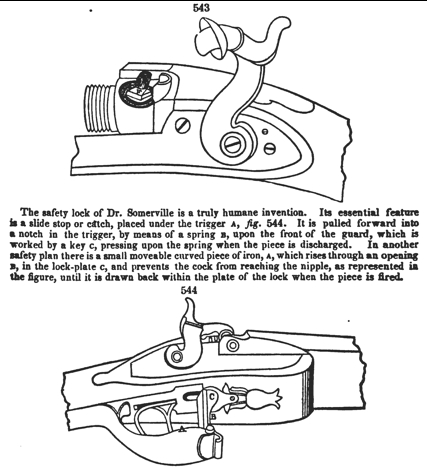 |
|
Illustration from Ure, Dictionary (1854), "Firearms"
|
Friedrich List, The National System of Political Economy (1841)
[List is another outlier in this collection. He believes in free markets and the beneficial operation of the division of labour within the Nation State but he recoils from the idea of the benefits of international free trade and the division of labour because of his concerns for the nation's military capacity, among other things.]
In like manner the entire manufacturing industry of a State in connection with its agricultural interest, and the latter in connection with the former, will prosper the more the nearer they are placed to one another, and the less they are interrupted in their mutual exchanges with one another. The advantages of their confederation under one and the same political Power in times of war, of national differences, of commercial crises, failure of crops, &c., are not less perceptible than are the advantages of the union of the persons belonging to a pin manufactory under one and the same roof.
Source: Friedrich List, The National System of Political Economy by Friedrich List, trans. Sampson S. Lloyd, with an Introduction by J. Shield Nicholson (London: Longmans, Green and Co., 1909). Chapter: Chapter XIII: THE NATIONAL DIVISION OF COMMERCIAL OPERATIONS AND THE CONFEDERATION OF THE NATIONAL PRODUCTIVE FORCES. </titles/315/30268/702653>.
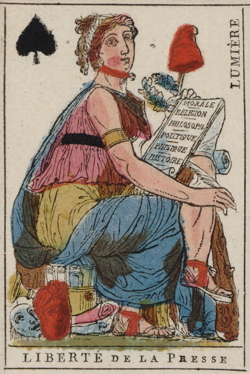 |
 |
[See a fuller discussion of these "revolutionary" playing cards on the OLL here.]
John Stuart Mill, Principles of Political Economy (1848)
[Mill's chapter on "Co-operation, or the Combination of Labour" is in many respects an extended commentary on Smith. In this pasage Mill discusses Smith's pin-making example (noting that there are 18 "degrees of the division of labour) and then Say's playing card factory (with 70 divisions) for which he provides a partial translation. A third example he cites is of Babbage and a watch making factory (with 102 divisions).]
§ 4. [The higher degrees of the division of labour] Thus far of the separation of employments, a form of the combination of labour without which there cannot be the first rudiments of industrial civilization. But when this separation is thoroughly established; when it has become the general practice for each producer to supply many others with one commodity, and to be supplied by others with most of the things which he consumes; reasons not less real, though less imperative, invite to a further extension of the same principle. It is found that the productive power of labour is increased by carrying the separation further and further; by breaking down more and more every process of industry into parts, so that each labourer shall confine himself to an ever smaller number of simple operations. And thus, in time, arise those remarkable cases of what is called the division of labour, with which all readers on subjects of this nature are familiar. Adam Smith's illustration from pin-making, though so well known, is so much to the point, that I will venture once more to transcribe it. "The business of making a pin is divided into about eighteen distinct operations. a One man draws out the wire, another straights it, a third cuts it, a fourth points it, a fifth grinds it at the top for receiving the head; to make the head requires two or three distinct operations; to put it on, is a peculiar business; to whiten the pins is another; it is even a trade by itself to put them into the paper. . . . . I have seen a small manufactory where ten men only were employed, and where some of them, consequently, performed two or three distinct operations. But though they were very poor, and therefore but indifferently accommodated with the necessary machinery, they could, when they exerted themselves, make among them about twelve pounds of pins in a day. There are in a pound upwards of four thousand pins of a middling size. Those ten persons, therefore, could make among them upwards of forty-eight thousand pins in a day. Each person, therefore, making a tenth part of forty-eight thousand pins, might be considered as making four thousand eight hundred pins in a day. But if they had all wrought separately and independently, and without any of them having been educated to this peculiar business, they certainly could not each of them have made twenty, perhaps not one pin in a day."
M. Say furnishes a still stronger example of the effects of division of labour—from a not very important branch of industry certainly, the manufacture of playing cards. "It is said by those engaged in the business, that each card, that is, a piece of pasteboard of the size of the hand, before being ready for sale, does not undergo fewer than seventy operations, every one of which might be the occupation of a distinct class of workmen. And if there are not seventy classes of work-people in each card manufactory, it is because the division of labour is not carried so far as it might be; because the same workman is charged with two, three, or four distinct operations. The influence of this distribution of employment is immense. I have seen a card manufactory where thirty workmen produced daily fifteen thousand five hundred cards, being above five hundred cards for each labourer; and it may be presumed that if each of these workmen were obliged to perform all the operations himself, even supposing him a practised hand, he would not perhaps complete two cards in a day: and the thirty workmen, instead of fifteen thousand five hundred cards, would make only sixty."
In watchmaking, as Mr. Babbage observes, "it was stated in evidence before a Committee of the House of Commons, that there are a hundred and two distinct branches of this art, to each of which a boy may be put apprentice; and that he only learns his master's department, and is unable, after his apprenticeship has expired, without subsequent instruction, to work at any other branch. The watch-finisher, whose business it is to put together the scattered parts, is the only one, out of the hundred and two persons, who can work in any other department than his own."
John Stuart Mill, The Collected Works of John Stuart Mill, Volume II - The Principles of Political Economy with Some of Their Applications to Social Philosophy (Books I-II), ed. John M. Robson, introduction by V.W. Bladen (Toronto: University of Toronto Press, London: Routledge and Kegan Paul, 1965). Chapter: CHAPTER VIII: Of Co-operation, or the Combination of Labour </titles/102/9701/722792>.
[Mill's chapter on "Co-operation, or the Combination of Labour" is in many respects an extended commentary on Smith. In this pasage Mill is concerned about the problem of OVER production. He wonders what will happen if the extraordinary productivity made possible by the division of labour results in unsold goods because the market is too limited to purchase it all. His answer is that commercial liberty applied to the entire world market will help manufacturers find outlets for the products.]
§ 6. [Limitations of the division of labour] The division of labour, as all writers on the subject have remarked, is limited by the extent of the market. If, by the separation of pin-making into ten distinct employments, forty-eight thousand pins can be made in a day, this separation will only be advisable if the number of accessible consumers is such as to require, every day, something like forty-eight thousand pins. If there is only a demand for twenty-four thousand, the division of labour can only be advantageously carried to the extent which will every day produce that smaller number. This, therefore, is a further mode in which an accession of demand for a commodity tends to increase the efficiency of the labour employed in its production. The extent of the market may be limited by several causes: too small a population; the population too scattered and distant to be easily accessible; deficiency of roads and water carriage; or, finally, the population too poor, that is, their collective labour too little effective, to admit of their being large consumers. Indolence, want of skill, and want of combination of labour, among those who would otherwise be buyers of a commodity, limit, therefore, the apracticala amount of combination of labour among its producers. In an early stage of civilization, when the demand of any particular locality was necessarily small, industry only flourished among those who by their command of the sea-coast or of a navigable river, could have the whole world, or all that part of it which lay on coasts or navigable rivers, as a market for their productions. The increase of the general riches of the world, when accompanied with freedom of commercial intercourse, improvements in navigation, and inland communication by roads, canals, or railways, tends to give increased productiveness to the labour of every nation in particular, by enabling each locality to supply with its special products so much larger a market, that a great extension of the division of labour in their production is an ordinary consequence.
Source: John Stuart Mill, The Collected Works of John Stuart Mill, Volume II - The Principles of Political Economy with Some of Their Applications to Social Philosophy (Books I-II), ed. John M. Robson, introduction by V.W. Bladen (Toronto: University of Toronto Press, London: Routledge and Kegan Paul, 1965). Chapter: CHAPTER VIII: Of Co-operation, or the Combination of Labour. </titles/102/9701/722802>.
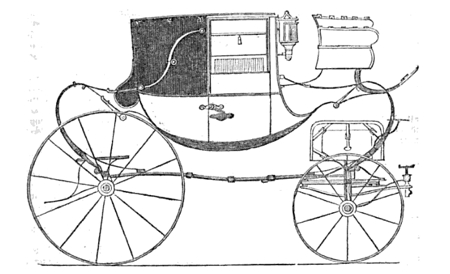 |
|
Illustration from Ure, Dictionary (1854), "Wheel Carriage"
|
Nassau William Senior, Political Economy (1850)
[Nassau Senior voices the objection that the specialization brought about by the division of labour might make it very difficult for a worker to transfer from one job to another. A worker in a pinmay be good at one task but have no experience in any of the others.]
The inequalities in wages and profits which we have as yet considered arise from causes inherent in the employments themselves which have been the subjects of discussion, and would, generally speaking, exist even if one occupation could at will be exchanged for another. But great inequalities are found which cannot be accounted for by any circumstances leading men to prefer one employment to another, and which therefore continue only in consequence of the difficulties experienced by the labourers and the capitalists in changing their employments.
The difficulty with which labour is transferred from one occupation to another is the principal evil of a high state of civilization. It exists in proportion to the division of labour. In a savage state almost every man is equally fit to exercise, and in fact does exercise, almost every employment. But in the progress of improvement two circumstances combine to render narrower and narrower the field within which a given individual can be profitably employed. In the first place the operations in which he is engaged become fewer and fewer. "In a pin-manufactory," says Adam Smith, "one man draws out the wire, another straightens it, a third cuts it, a fourth points it, a fifth grinds it at the top for receiving the head; to make the head requires two or three distinct operations; to put it on is a peculiar business; to whiten the pins is another; it is even a trade by itself to put them into the paper; and the important business of making a pin is in this manner divided into about eighteen distinct operations." In a large manufactory the man who is engaged in one of these operations has little experience in any of the others.
And, in the second place, the skill which the division of labour gives to each distinct class of artificers generally prevents whatever peculiar dexterity an individual may have from being of any value in a business to which he has not been brought up. A workman whose specific labour has ceased to be in demand finds every other long-established employment filled by persons whose time has been devoted to it from the age at which their organs were still pliable and their attention fresh.
Source: Nassau William Senior, Political Economy (London: Richard Griffin and Co. 3rd ed. 1854). Chapter: DISTRIBUTION OF WEALTH. </titles/116/36060/902966>.
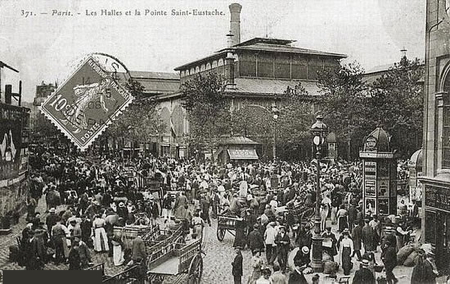 |
|
Les Halles Markets in Paris
|
Frédéric Bastiat, Economic Harmonies (1850)
[Bastiat believes that the benefits of the division of labour (or what he calls "the co-operative use of muscle power for a common goal:) are exaggerated when compared the benefits to be had from free exchagne and the use of our other faculties such as the intellectual faculites. The division of labour is only one of many ways in human beings can cooperate for mutual benefit.]
And yet the co-operative use of muscle power for a common goal is a mere nothing. Nature has given us highly varied physical, moral, and intellectual faculties. There are inexhaustible combinations in the co-operative union of these faculties. Do we need to carry out a useful project, like building a road or defending our country? One places his strength at the disposal of the community; another, his agility; another, his daring; still another, his experience, his foresight, his imagination, even his renown. It is easy to understand that the same men, working separately, could never have accomplished, or even contemplated, such an undertaking.
Now, the joining of men's forces implies exchange. To gain their co-operation, they must have good reason to anticipate sharing in the satisfaction to be obtained. Each one by his efforts benefits the others and in turn benefits by their efforts according to the terms of the bargain, which is exchange.
We see how exchange, in this form, adds to our satisfactions. By the mere fact of their union, efforts equal in intensity produce superior results. Here there is no trace of the so-called barter of the superfluous for the necessary, nor of the double and empirical profit alleged by Condillac.
We may make the same observation concerning the division of labor. Indeed, if we look closely at the matter, we see that the diversification of occupations is only another, more permanent, way of joining forces, of co-operating, of forming an association; and it is altogether accurate to say, as will be shown later, that the present social organization, provided the principle of free exchange is recognized, is the most beautiful, most stupendous of associations—a marvelous association, but very different from the associations dreamed up by the socialists, since in it, by an admirable arrangement, the principle of individual liberty is recognized. All men, at all times, may join or leave it at their pleasure. They contribute what they will; they receive in return a constantly increasing degree of satisfaction, which is determined, according to the laws of justice, by the nature of things, not by the arbitrary will of a chief. But I should not anticipate what I shall say later. All that I have to do at the moment is to explain how the division of labor adds to our strength.
Without dwelling on this subject, one of the few that has not provoked controversy, I do have something to say that is not without value. Perhaps, indeed, its importance has been minimized. To demonstrate the power of the division of labor, writers have been content to point out the marvelous things it accomplishes in certain industries, pin manufacture, for example. The question can be given broader and more philosophical significance. Moreover, habit has the peculiar power of making us shut our eyes and lose sight of the things around us. There is no truer word than that of Rousseau: "It takes a great deal of scientific insight to observe what we see every day." It is not superfluous, then, to call to men's attention what they owe to exchange without being aware of it.
How has the power of exchange raised humanity to its present heights? By its influence on labor, on the harnessing of the forces of Nature, on the capacities of man, and on capital.
Adam Smith has well shown this influence on labor.
"The increase in the quantity of labor that can be performed by the same number of men as a result of the division of labor is due to three factors," said the celebrated economist: "(1) the level of skill acquired by each worker; (2) the saving of time normally lost by moving from one occupation to another; (3) the increased opportunity each man has of discovering easy and efficient ways of attaining an object when his attention is centered on it, rather than diverted to many other things."?
Those who, like Adam Smith, see in labor the sole source of wealth, confine themselves to the question of how division improves its efficiency. But we have seen in the preceding chapter that labor is not the only agent for procuring our satisfactions. Natural forces also contribute. This is not open to question.
Source: Frédéric Bastiat, Economic Harmonies, trans by W. Hayden Boyers, ed. George B. de Huszar, introduction by Dean Russell (Irvington-on-Hudson: Foundation for Economic Education, 1996). Chapter: 4: Exchange. </titles/79/35504/66797>.
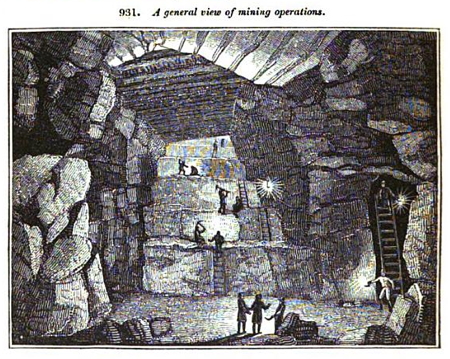 |
|
Illustration from Ure, Dictionary (1854), "Mines"
|
Horace Say, Dictionnaire de l'économie politique (1852)
[Horace Say, the son of J.B. Say, summarizes Smith's and Say's arguments but chastises them for not taking their analysis further to include all the other parties which had to cooperate to get the metal to the pin factory before the production of pins could begin. Here Say is arguing much like Leonard Read does in his classic essay "I, Pencil" (1958) </titles/112>. Horace also counters the critics of the moral disadavages of the hyperspecialisation of the division of labour by reminder us that men are not just workers but also members of a family, citizens of a nation, and a full participant in the society in which he lives. He concludes by arguing that the division of labour applies not just to large factories but also makes possible the proliferation of small, privately owned businesses such as he sees around him in a metropolis like Paris.]
—J. B. Say has taken as his example the manufacture of playing-cards, and there is no branch of industry in which immensely greater results are not obtained from the co-operation of individual effort and the division of employments—If Adam Smith had extended his analysis, he might have shown that many other partial operations are divided among different workmen to complete that small product of human industry the value of which is so little, and which is called a pin. He might have directed attention to the work of the miner who brings to the surface of the earth the ore of copper, and to that of the miner having a different origin and habits, who, in another part of the world perhaps, has had to dig out the ore of tin necessary for alloyage and for whitening the pin. But in addition to the labor necessary to bring these metals to the requisite degree of purity, they must besides have been transported by sea and by land to the pin-maker's manufactory How many different operations divided among an infinite number of workmen have not been necessary in the mere construction of the ship employed in carrying the tin from a port of India to England! And what shall we say of the compass which has been used in guiding this vessel across the seas? What an amount of time and of observations of different kinds, by a great number of individuals, was necessary to put mankind in possession of the compass! The imagination is appalled at the extent of the research needed to exhibit all the labor which has been necessary to bring to perfection the most trifling product, in a single branch of any manufacturing industry of our day…
—The advantages of the division of labor in the production of wealth are, therefore, incontestable; but we must not forget to call attention to the drawbacks which may be consequences of these advantages. The most glaring and one specially calculated to attract the attention of generous minds, is the effect which the restriction of a man to a single piece of work always the same and constantly repeated, may have upon his moral development. It is a melancholy thing, it has been observed, for one reaching the end of life to have to realize that his every day has been passed in making pin heads. Those who present the disadvantages of the division of labor under this dramatic form are, in part at least, unjust to humanity. Man must not be thus personified in the only work which it is his business to do; though a worker, he is one of a family; he is a citizen; in addition to the labor which he gives in exchange for the services of others of which he has need, he participates in all the advantages of the society in which he lives; he has his share in the progress made about him. In all vocations the working man has intervals of rest, and it is especially according to the use to which he turns his spare moments that man can elevate himself and come to enjoy the general advantages offered him by society. A steady and unvaried occupation does not necessarily dull the mind; and the artist who, during a year or two, grows pale over the same plate of copper or steel that he may produce a master-piece, does not live wholly amid the regular lines traced successively by his graver.
—It would, moreover, narrow the question of the division of labor to see it and to study it within the walls of a manufactory only; it is not less worthy of observation in the little work shops of a great city like Paris. There, occupations are not only apportioned among the workingmen employed, but also among a great number of petty manufacturers, each the possessor of a small capital, each conducting for himself some undertaking and affording employment to one or two workmen and an apprentice. A single little article of Parisian manufacture is thus often the result of the successive co-operation of many; for instance, the wood-work of a lady's work box is made by a cabinet maker; each separate article which goes to complete it comes from a distinct trade, that of the turner, the cutler, the engraver, etc.; while finally, another tradesman, a furnisher, having selected these different articles, fits up the inside of the box. In the manufacture of artificial flowers the division of the labor of workmen and of manufacturers into departments is carried to quite as great an extent. The manufacture of what are called the preparations for flowers is very extensive, and gives rise to important industries; there are color makers, and mould makers, those who crimp the cloth, and those who make the stamens, the seeds and other accessories, and all these different people hand over their productions to the monteurs; among these latter, again, some make buds only, others roses, and others mourning flowers, and so on. This great division of labor largely reduces the cost of production, and the article is of improved quality. It may be observed, also, that among this vast laboring class where each one's employment is so narrow, quickness of wit and intelligence is developed to a much greater extent than in vocations where work is less subdivided.
Source: John Joseph Lalor, Cyclopaedia of Political Science, Political Economy, and of the Political History of the United States by the best American and European Authors, ed. John J. Lalor (New York: Maynard, Merrill, & Co., 1899). Vol 1 Abdication-Duty. Chapter: DIVISION OF LABOR. </titles/1679/2981/1446007>.
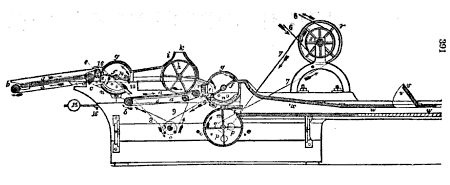 |
|
Illustration from Ure, Dictionary (1854), "Cotton Manufacture"
|
Dugald Stewart, Lectures on Political Economy (1855)
[Stewart takes Smith to task for placing too much emphasis on hand labouring and not enough on the use of machinery to replace hand work. Stewart thinks that pin making requires little manual dexterity and that the real explosive growth in British manufacturiing is the result of the introduction of machinery which has replaced manual labour.]
In this view of the subject, there is unquestionably a great deal of truth. But it may, I think, be reasonably doubted, whether Mr. Smith has not laid too much stress on it, in accounting for the advantages gained from that astonishing division and subdivision of labour which takes place in some of the arts. That the rapidity of the hand in executing a mechanical operation, may be increased by practice to a very great degree, is an acknowledged fact. But there is obviously a limit, beyond which this rapidity cannot possibly be carried; and I am inclined to think, that in such very simple operations as drawing out a wire, &c., it is not very long before this ultimatum in point of rapidity is reached by the workman. Nor can I bring myself to believe, that after it is attained, the dexterity of the workman in performing this one operation would be at all impaired, though he should also have acquired a few other accomplishments of a similar nature: that the drawer of the wire would be less fitted for his employment, if he changed occupations for a day or two with the cutter or pointer of the pin. Indeed, I know of few manufactures where great manual dexterity is less required, than in that of pin-making. Even in those establishments which employ the labour of the hand to perform various operations, which in richer manufactures are accomplished by means of machinery, a very considerable part of the work is executed by children. Hence I am led to conclude, that though one of the advantages of the division of labour be to increase the rapidity of manual work, yet this advantage bears so very small a proportion to that which is gained in the last result, that it is by no means entitled to stand at the head of the enumeration; and certainly goes a very little length in accounting for that minute division and subdivision of labour which has been introduced into some of the most prosperous manufactures of this country. On this head, therefore, I entirely agree with a remark of Lord Lauderdale in his Inquiry into the Nature and Origin of Public Wealth, where he observes, that even in the trade of the pin-maker, without the use of machinery to supersede the work of the hand, no great progress could have been made in the rapidity with which pins are formed.
Source: Dugald Stewart, Lectures on Political Economy. Now first published. Vol. I. To which is Prefixed, Part Third of the Outlines of Moral Philosophy, edited by Sir William Hamilton (Edinburgh, Thomas Constable, 1855). Chapter: [SECT. I.—: ON THE CIRCUMSTANCES WHICH RENDER LABOUR MORE EFFECTIVE.] <Detail from an illustration in "Épinglier" in the Encyclopédie>.
